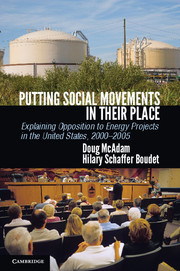 Putting Social Movements in their Place
Putting Social Movements in their Place Book contents
- Frontmatter
- Contents
- Acknowledgments
- 1 From Copernicus to Ptolemy and (Hopefully) Back Again
- 2 Comparing Communities “At Risk” for Mobilization
- 3 Explaining Variation in the Level of Opposition to Energy Projects
- 4 Does Opposition Matter?
- 5 From Not in My Backyard to Not in Anyone’s Backyard
- 6 Back to the Future
- Appendix A Additional Community Data Collected Not Used in Causal and Outcome Condition Scoring
- Appendix B Raw Data and Methods for Scoring Causal Conditions
- Appendix C Interview Sources by Case
- Bibliography
- Index
3 - Explaining Variation in the Level of Opposition to Energy Projects
Published online by Cambridge University Press: 05 June 2012
- Frontmatter
- Contents
- Acknowledgments
- 1 From Copernicus to Ptolemy and (Hopefully) Back Again
- 2 Comparing Communities “At Risk” for Mobilization
- 3 Explaining Variation in the Level of Opposition to Energy Projects
- 4 Does Opposition Matter?
- 5 From Not in My Backyard to Not in Anyone’s Backyard
- 6 Back to the Future
- Appendix A Additional Community Data Collected Not Used in Causal and Outcome Condition Scoring
- Appendix B Raw Data and Methods for Scoring Causal Conditions
- Appendix C Interview Sources by Case
- Bibliography
- Index
Summary
In Chapter 1, we spelled out four principal research questions that we hoped toaddress in the book: How much emergent collective action do we see across thetwenty communities we are studying? What causal conditions explain variation inthe level of mobilization in these communities? Net of other factors, whatinfluence, if any, does the level of mobilized opposition have on the outcome ofthe proposed project? Finally, why did opposition to one kind of energy project– liquefied natural gas (LNG) terminals – grow into broaderregional movements in some parts of the country but not others? In this chapter,we take up the first two of these questions. We aim to establish something of abaseline of just how much emergent collective action we see across the twentycommunities we are studying and then move to see if we can identify certainmixes of factors – or “recipes” in the language of fuzzyset/Qualitative Comparative Analysis (fs/QCA) – that helpaccount for variation in level of mobilization across these locales. We beginwith a basic description of the level and forms of emergent collective action wefound in the twenty communities that we have come to know so well throughout thepast few years.
ESTABLISHING A BASELINE
A newcomer to the United States would be forgiven if, in reading the socialmovement literature, she or he imagined that our communities were awash inprotest activity. In a 2005 article, McAdam and colleagues (2005: 2) argued thatthe field’s initial engagement with and continued interest in themovements of the 1960s had “created a stylized image of movements thatthreatens to distort our understanding of popular contention . . .in the contemporary U.S. . . . This stylized view tends to equatemovements with:
Disruptive protest in public settings
Loosely coordinated national struggles over politicalissues
Urban and/or campus-based protest activities
Claim making by disadvantaged minorities.”
Information
- Type
- Chapter
- Information
- Putting Social Movements in their PlaceExplaining Opposition to Energy Projects in the United States, 2000–2005, pp. 54 - 97Publisher: Cambridge University PressPrint publication year: 2012